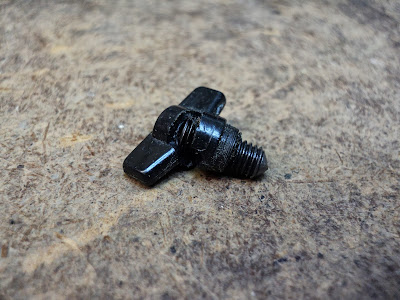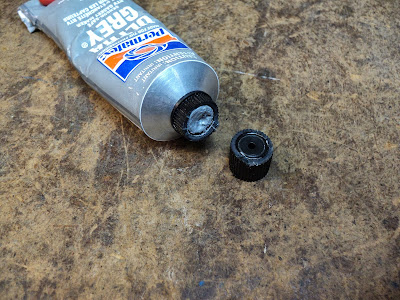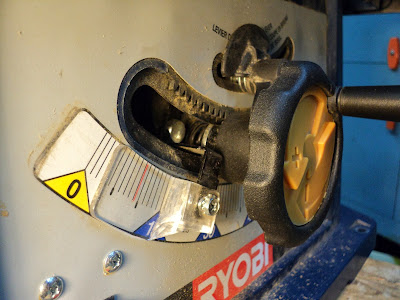This is an old-timer. It predates variable speed, and it's not reversible. It's either off, or it's on full-bore clockwise -- that's it.
The drill was made by PET U.S.A. for sale in Canada via Portable Electric Tools (Canada) Ltd. Here's a view of the drill's I.D. plate that's on top.
Portable Electric Tools is no more. There are some brief notes about the firm here.
This drill runs, but it's probably about time it got some TLC, and fresh grease in its gearbox. I'll tear it down completely and tend to it.
- - -
Teardown
1) Chuck
The chuck is a Supreme H13A. The chucks on non-reversible small drills typically just thread onto a 38"-24 spindle in the conventional manner. To remove one, insert the chuck key's pilot into one of the holes, and give the chuck key's shank a sharp, forceful rap with a hammer in the rotation direction. The chuck will loosen, and can then be fully unscrewed.
I'll set that chuck to soak in the parts washer; it has a bit of a grungy feel to its action.
- - -
2) The Right Side Casing Half
- Two 8-32 x 1 1/4" screws at the front.
- Three 8-32 x 3/4" screws at the rear.
- The casing half just lifts away, bringing you to here.
- - -
3) The Switch w/Line Cord
NOTE: The wiring in any motor can be a real headache come reassembly time. There's seldom much space to accommodate it, and it often must be run/lain in a very particular way. It's a good practice to sketch or photograph the wiring before dismantling any motor.
This machine is not too bad for wiring difficulty; some are much worse -- beware.
This switch employs 'poke home' type wiring connections. Inserting the shank of a 1/16" twist drill in the opening alongside a wire will back off the wire's retention tang and free it.
This switch's wiring is about as simple as it ever gets. Reversible drills' switch connections can be bewildering -- a sketch made before disconnecting anything is strongly advised.
I'll give the switch a good shot of WD-40 -- switches like that stuff. That incoming line cord wiring is in dreadful condition; I'll deal with that later.
- - -
4) The Brushes
The brush caps unscrew for brush removal.
It's not essential, but it's a good practice to scribe brushes with their position and orientation as you're removing them. I've scribed these brushes 'UR' (Upper Right) and 'LR' (Lower Right). Maintaining brush position and orientation minimizes brush wear -- the brushes go back into service seated exactly as they were.
- - -
5) The Motor's Field And Armature
- Four 4-40 x 5/16" pan head screws to free the bronze bearing retainers.
- The item just lifts out. NOTE that there is a semicircular oil wick tucked away under the rear bearing. Remove it.
- As with brushes, it's a good practice to scribe bearings so they can go back in place after cleaning exactly as they were.
- NOTE the presence of thrust washers. You'll want to be certain of getting any and all thrust washers back in place exactly as they were. Here's a view of the field and armature out of the drill.
And that's as far as I'm going. Here's a closer view of the gear-train that I'm not going to attempt to dismantle.
I'm unsure of how that comes apart, and I can't risk damaging anything with ignorant tinkering.
I'll dig out the sludgy old grease, and flush the gearbox as well as I can. I'll give any bronze bearings plenty of oil afterward to replenish what the parts washer solvent might deplete. Then I can pack in fresh grease.
- - -
The Gear-Train As Good As It's Gonna Get
Here's the gear-train after much flushing and digging and brushing and compressed-air blowing.
I'll start giving the bronze bearings plenty of oil, well before I repack the gearbox with grease.[1]
Next up is to clean all the remaining components, and burnish the commutator. I'll deal with the shabby input wiring, repack the gearbox and reassemble the tool.
- - -
Nearly Done
Here's a view of the machine about to have its right side cover reinstalled.
The commutator is marginal. I suspect it's been turned down at least once in the past. It's very nearly at the point where its mica ought to be undercut.
I couldn't save the original line cord strain relief, so I went with a conventional grommet with a ty-wrap to take tugging forces.
- - -
All Done, Almost
Here's the finished drill.
It has a leashed chuck key, per my usual method, and it runs beautifully.
The only thing missing is a screw-in side handle. The drill has 14"-20 provision for a handle at either side, but the original handle is long gone. I'll have to fabricate one.
- - -
A Screw-In Side Handle
A pleasant bit of wood turning got me a handle. Here's what I started with.
And here's what I ended up with.
And here's a view of the handle installed on the drill.
Just the thing for drilling holes in concrete when the drill has no 'hammer' feature -- you can really lean on the thing.
- - -
Note:
[1] The grease I use for gearboxes like this one is Canadian Tire's No. 28-0422-2 Wheel bearing & Chassis Lubricant. Similar products are no doubt available everywhere.
For all that I really know about grease lubricants, there may well be a better grease for the purpose. A local warranty repair shop for any of the major toolmakers might be a good place to ask.
# # #
# # #

















































